Strider PT CC Review

From that silhouette alone you know what knife this review is about, or at least which brand (provided you ignored the title of the post). That profile is famous among knife knuts and for good reason. It is the profile of one of the most expensive, controversial, and storied production knives in modern times. From the price, to the fit and finish, to the maker--nothing about Strider is without controversy.
The PT was a model that many Strider fans were not thrilled with from the beginning. It did not fit their idea of what a Strider folder was, in large part because it was too small. Striders were beast blades, not pocket trinkets. But over time folks warmed up to an Strider-shaped knife that was eminently pocketable. But there were problems with the pivot screw and the lock face geometry. Time and again the PT would go out of production and come back with a tweak. This is not a bad thing. It is a testament to Strider's commitment to getting things right. Would you prefer they do nothing and let a slightly substandard product leave their production facilities for sale? But it did make buying one a challenge. One other thing that made finding a PT vexing was their tendency to produce only PT or PT CC versions at one time. Every time I though I could tolerate the roughly handle scales of the PT model, the CC was the only thing available and vice versa. Finally, I decided to bite the bullet, having handled a PT CC at a recent knife show and falling under its thrall immediately. About a month and half ago a small package arrived with my PT CC, a Ranger Green model. It has been my most carried knife ever since (even more than the Dragonfly). This, my friends, is one hell of a blade.
is the product page. There is a great deal of price uniformity. New PTs of either variety cost $300.
is a written review.
is a video review. Here is a link to Blade HQ, where you can find the Strider PT, and all proceeds benefit the site when you purchase things through this link (they come in small waves so they may not be in at Blade HQ when this review goes live):
Finally, here is my beloved PT CC:

Twitter Review Summary: Perfectly sized, sumptuously finished, and cuts for an eternity--an ideal EDC with one flaw...
Design: 2
The ratios are above average to very good. The blade:handle is .73 (much worse if you subtract the choil, but I actually prefer a choil as it makes the cutting edge more useful than simply adding length). The blade:weight is 1.15 (again worse if you are looking at just cutting edge). These are not all time greats, but the blade:weight is quite good. The blade:handle is probably around average (one day I am going to go back and calculate all of the data so I know what average is).
Here is the PT CC up next to the Zippo a.k.a. the common object used for size comparisons.
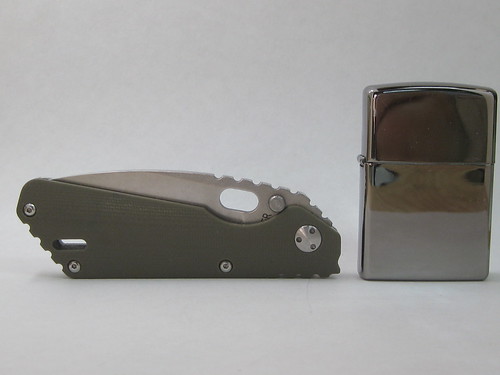
Here is the PT CC in my medium sized hands:
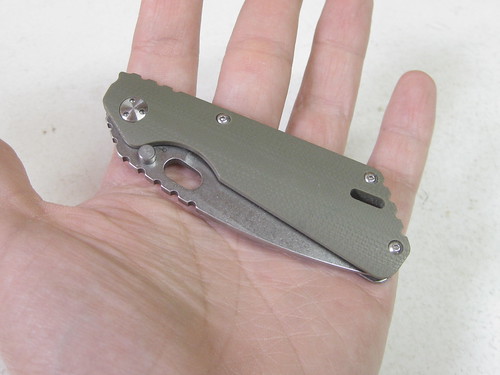
Fit and Finish: 2
If you watch DarkChild's review (the link above) for the PT you are left with this impression that this is an overpriced undercooked blade. Warnings like this one confirm that reputation. Undaunted, I ordered one anyway and what arrived was simply put the finest finished knife and perhaps piece of gear I have ever handled. Only the
, the
, and the
are in the same league. Even the vaunted
is not QUITE the polished beauty that the PT CC is. It starts with the blade, of course. There is a small angled cant to the knife when the blade is open giving the edge an aggressive posture towards the cutting material. The edge and grind are spectacular, more on that below, but the stonewash is like nothing I have ever seen. It is glorious, almost jewel like.
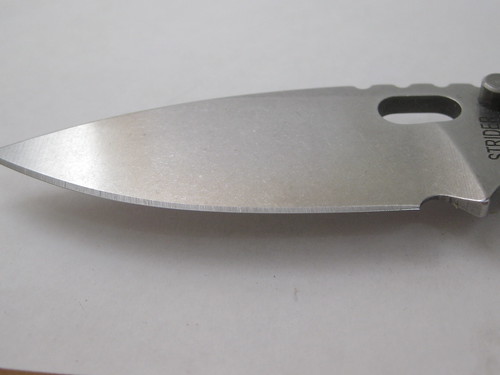
The convex handles are nicely shaped and fall into the hand perfectly during use. The entire knife has a buffed feel to it, as if it has been used for a decade and then refinished to bring the materials back to a high level of polish. The G10 is smooth, not as smooth as a silken G10 on the
, but pretty darn nice. The jimping is smooth in on direction, but grippy in the other. The lock is well made, but more that below. Perhaps Strider has gotten better at QC or perhaps the CC lines are fussed over more. Whatever the answer, there is no reasonable basis to complain about fit and finish on this knife. It is as good as I have seen on a production blade.
Grip: 2
This is, folks, why that silhouette is so well-known. These knives, from the biggest SMF to this, the smallest PT, simply melt in your hand. The choil is excellent, allowing for excellent control of the cutting edge, and the rest of the knife handle fills your hand. The jimping on the knife is quite good and well-placed. Just letting this knife rest, in place, across your fingers tells you how well designed it is. Every single cut and curve, every straight line and run of jimping is in service to the act of cutting. This knife is among my favorite folders in the hand, and despite its diminutive size, it allows for a comfy four finger grip.
Carry: 2
The PT CC's light weight and curved shape go a long way in making this a very pocketable knife. One thing that seems like a small touch but really puts this knife over the time in terms of carry, is the thoroughly smoothed out and polished feel. It is as if this knife has been carried and handled everyday for a decade, gaining the softened edges and warmth that regular use provides. This knife has Atwood's famous "buttered" edges on virtually every surface. All of this makes for a glorious, pocket-friendly blade.
Steel: 2
Ah...S35VN. I really do like this stuff, this being the fourth knife I have reviewed with Crucible's next-gen EDC steel. It holds an edge very well. It is not impossible to sharpen. It resists all forms of corrosion that you'd encounter during normal wear and use. The standard cutting test tasks--push cutting paper and cardboard and whittling wood--were very easy here. The knife didn't come insanely sharp out of the box, but the edge held up well over a long month of cutting. Additionally because of the thick blade stock, it was more durable than a knife of this size would normally be.
Blade Shape: 2
That blade shape...oh...that blade shape. It is the classic spear point Strider and though they have branched out significantly from this original shape it is because of a desire to experiment, not any problems they incurred. This is perhaps, my favorite all time blade shape, better than the Sebenza's clip point because the tip is sturdier.
Behold, the classic:
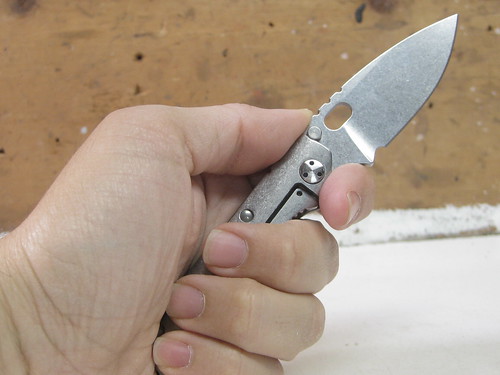
Also I know a lot of people grumble about the cutting edge consuming choil but the reality is the control it gives you over the blade is well worth the trade off. Every roll in which you could reasonable use this knife, the choil is worth the real estate.
Grind: 2
The grind is a virtually full flat grind. That is pretty awesome. The cutting bevel is quite well done. No complaints there. But the star here is the ricasso. Really, you might be asking, the friggin' ricasso? Yes, the ricasso. How many shit ricassos have you seen? Even on expensive knives? Tons. How many on Spyderco knives? Tons. Yet here, it works. Not only does it prevent your finger from getting sliced if it moves forward and out of the choil, it makes sharpening the ENTIRE cutting edge a dream.
Deployment Method: 2
I GUESS you could the thumb studs, if you really, really had to, but the best bet for ideal performance is the oval thumb hole. The positioning is just right (hitting close to the Spyderco magic number of 1.1 inches, I get something just over 1 inch here).
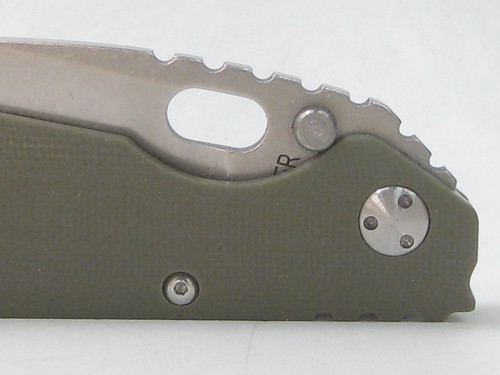
The hole is cut sharply enough to grab the fat pad on your thumb (who you callin' fat?). And the pivot flows like a jeweled movement on a watch. This isn't the fastest set up in the world, but it is a very, very good one.
Retention Method: 0
No clip. So sad.
. Oh yeah, I hate lanyards.
Lock: 2
Look at that, just look AT THAT:
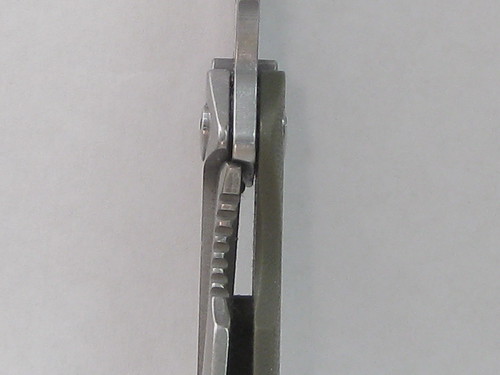
After some fidgeting, Strider got it right. The angled face and angled tang meet up in perfect unison and the result is a strong, stable lock, but one that disengages quickly when you mean to do so. Also, the jimping on the lock bar aids in disengagement.
Overall Score: 18 out of 20
This is about as good as you can get for an EDC knife. I like it better than my Sebenza and at least as much as the
. It is a superior tool, with exalted fit and finish. I just miss having a pocket clip. As much as I tried, I couldn't get around not having one, and so I decided to have one made. See here for more details. This knife is just better than the normal PTs I have handled. There are so many little touches that make it insanely great. I love this knife. If this particular PT CC is an example of the entire line, Striders are, in my opinion, worth they money and earn their reputation. This is a great pocket knife.
The cost is something that warrants its own special comment. Andrew often points out on the podcast that he is not sure why these knives are so expensive. S35VN is a great steel, but it is not exactly Damascus or SM100. The framelock is well made, but so are many framelocks on cheaper knives, such as the
, and it is not often that the ZT560 is the cheaper knife in a discussion. What gives? What makes this tiny blade worth $300? First, like the Sebenza, it does a lot of things very, very well. It has thicker than normal steel for a blade of this size, meaning that it can cut and pry more than you'd expect for a 2.75 inch blade. The blade shape is quite nice and very useful. The fit and finish is superb. There is just very little this knife does poorly. It is an all-around performer. But for me the thing that sets this apart from other knives, even the Sebenza, is the ergonomics. Let's be honest--Spyderco schools the rest of the cutlery world on ergonomics. Very rarely do knives beat the Spyderco of the same size and price. Its their thing (and a good thing to specialize in). But with the Strider, I think I have found a knife that has the fit and finish of a Sebenza (or maybe a little more) with the ergonomics of a Spyderco (or maybe a little more).
At this point, I have reviewed so many things and I have had so many knives pass through my hands that I don't really have any buyer's attachment, even to a $300 blade. If it stunk I would say so, but here, it doesn't. I really, really like the PT CC. It is a great but imperfect EDC knife. It is worth the hassle of tracking it down.
Update: 17 out of 20, 1 point off for grind.
Over the years I have come to realize that the grind on this knife is just too thick. The problem with the blade, made evident by the use of things like the
, is that the blade is just monstrously thick behind the cutting edge. That final cutting bevel grind is so acute in large part because of the stock's thickness that the knife cut poorly in places where slicing was required. It is hardly a shock to say this, but the Strider is better for hard use tasks, and given the size of the PT and my needs, that combination--small but pry capable--never came up. Even compared to the also port stock of the Techno, the Strider wasn't a great cutter, and, in the end, that is why you own a knife.
